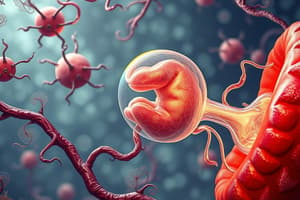Podcast
Questions and Answers
What phase of hematopoiesis begins on the 19th day of embryonic development?
What phase of hematopoiesis begins on the 19th day of embryonic development?
Mesoblastic Phase
At what gestational weeks does the hepatic phase begin?
At what gestational weeks does the hepatic phase begin?
4-5 gestational weeks
Which blood cell types begin to appear during the hepatic phase?
Which blood cell types begin to appear during the hepatic phase?
- Erythroblasts
- Granulocytes
- Monocytes
- All of the above (correct)
What becomes the primary site of hematopoiesis by the end of the 6th month?
What becomes the primary site of hematopoiesis by the end of the 6th month?
Which type of marrow is hematopoietically active?
Which type of marrow is hematopoietically active?
Yellow marrow is active in hematopoiesis.
Yellow marrow is active in hematopoiesis.
Which organ serves as the largest lymphoid organ in the body?
Which organ serves as the largest lymphoid organ in the body?
What are the main functions of lymph nodes?
What are the main functions of lymph nodes?
What process involves phagocytosis of senescent red blood cells?
What process involves phagocytosis of senescent red blood cells?
The __________ is capable of extramedullary hematopoietic production in case of bone marrow shutdown.
The __________ is capable of extramedullary hematopoietic production in case of bone marrow shutdown.
Flashcards are hidden until you start studying
Study Notes
Hematopoiesis Overview
- Process of blood cell formation during embryonic development and throughout life.
Mesoblastic Phase
- Commences around the 19th day post-fertilization.
- Hematopoietic stem cells (HSCs) arise from the aorta-gonad-mesonephros region.
- Mesodermal cells develop primitive erythroblasts.
- Angioblasts contribute to the formation of future blood vessels in the yolk sac.
Hepatic Phase
- Begins at 4-5 gestational weeks.
- Characterized by clusters of developing erythroblasts, granulocytes, and monocytes.
- Transition from yolk sac hematopoiesis to liver-based hematopoiesis.
- Lymphoid cells start to appear during this phase.
- Liver hematopoiesis peaks during the third month of fetal development.
- Thymus becomes a major site for T-cell production; kidneys and spleen produce B-cells.
- Megakaryocyte production starts within this phase.
Medullary Phase
- Begins at the 5th month of gestation in the bone marrow.
- Myeloid activity becomes prominent.
- Myeloid to erythroid ratio reaches an adult level of 3:1 by 21 weeks.
- Bone marrow becomes the primary site of hematopoiesis by the end of the 6th month.
- Detectable levels of erythropoietin, G-CSF, GM-CSF, fetal Hgb, HbA2, and adult Hgb are visible.
Adult Hematopoietic Tissue
- Comprised of primary lymphoid tissue (bone marrow, thymus) and secondary lymphoid tissue (spleen, lymph nodes, gut-associated lymphoid tissue).
Bone Marrow
- Located within the cavities of cortical bone, resembling a honeycomb structure (trabecular bone).
- Types of marrow include:
- Red Marrow: Hematopoietically active, found in sternum, skull, scapulae, vertebrae, ribs, pelvis, and proximal ends of long bones.
- Yellow Marrow: Inactive, primarily composed of adipocytes (fat cells).
Bone Marrow Development
- Infancy and early childhood consist of primarily red active marrow.
- By age 5-7, active marrow is restricted to flat bones and major axial bones.
- Yellow marrow can revert to red marrow during increased demand.
Red Marrow Structure
- Composed of extravascular cords with blood cell lineages, stem cells, and macrophages.
- Normoblasts develop in clusters near sinus surfaces.
- Megakaryocytes proximity to vascular walls facilitates platelet release.
Liver Functions in Hematopoiesis
- In severe anemia, increases bilirubin conjugation and iron storage.
- Sequesters damaged red blood cells (RBCs) from circulation.
- Capable of extramedullary hematopoiesis in case of bone marrow failure.
Spleen Functions
- Largest lymphoid organ, located beneath the diaphragm.
- Acts as a nonspecific filter for circulating blood and synthesizes IgM.
- Serves as a storage site for platelets.
Methods for RBC Removal
- Culling: Phagocytosis and degradation of senescent RBCs.
- Pitting: Splenic macrophages remove damaged parts of RBCs.
Lymph Nodes
- Bean-shaped organs located along lymphatic vessels, varying in size (1-5 mm diameter).
- Organized in groups; can be superficial (e.g., inguinal, axillary) or deep (e.g., mesenteric).
- Key functions include:
- Formation of new lymphocytes in germinal centers.
- Processing of specific immunoglobulins.
- Filtering particulate matter, debris, and bacteria from lymph fluid.
Studying That Suits You
Use AI to generate personalized quizzes and flashcards to suit your learning preferences.




